#and on their site they had this big list of endangered animals…..
Photo

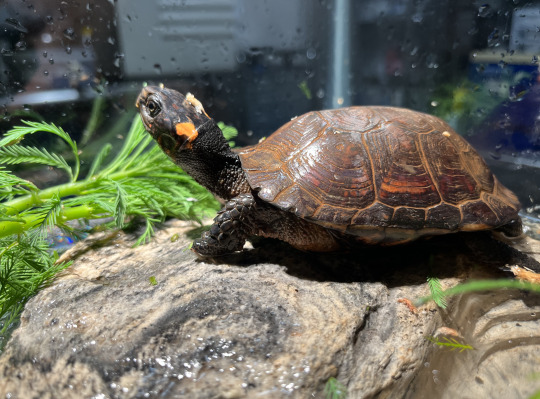
😲 Endangered species alert! 😲
Researchers at Virginia Tech discovered a Bog Turtle on their study site that looked to be in questionable health and needed an expert opinion and they brought it to us. Bog Turtles are listed as threatened Endangered Species Act and are listed as locally endangered in Virginia, threatened by the illegal poaching and trade of this species, habitat loss/fragmentation, degrading water quality, mortality from car strikes, and growing populations of predators (such as raccoons).
Bog Turtles are so highly sought after by the illegal pet trade that there are several cases of poachers breaking into high security zoos and other facilities to steal them. This is why we are only posting that we had this beautiful turtle AFTER the fact — after an exam determined this individual was healthy he was returned back to the wild. Illegal wildlife trafficking is a SERIOUS problem that is killing creatures like this one. Don't encourage the abduction of wild animals, and if you suspect a wildlife crime is occurring, you can call 1-800-237-5712 to leave an anonymous tip.
We would like to give big thanks to the Virginia Department of Wildlife Resources and researchers at the Virginia Tech College of Natural Resources Staff for trusting us to evaluate such a sensitive, rare, and beautiful animal.
You can donate to help us at swvawildlifecenter.org/make-a-donation/
36 notes
·
View notes
Text
Summer and autumn 2020: All kinds of news about Joshua trees. Over 1 million Joshua trees, and one of the largest single Joshua tree woodland areas, destroyed by fires. Within days (as of September 2020), California state institutions will also vote on whether or not to begin survey and consider listing western Joshua trees as a formally “endangered” species, a decision which the state has been delaying for months. Ecologists say that there are actually 2 species of Joshua tree, and the western species is under critical threat of extinction. New (July 2020) academic research describes how expanding solar-power industry disrupts soil, Mojave Desert, and Joshua tree ecology. Local government institutions continue to tear down the trees, as resource extraction groups (including solar-power industry companies) oppose protections for the succulent plant. (Update from October 2020: California did vote to recognize western Joshua tree as endangered, but business/development interest groups are launching legal campaigns to reverse the decision.)


California Fish and Wildlife commissioners are scheduled to vote next week [September 2020] on whether the state should enter into a year-long study on Joshua trees. At the end of the study, the commission will consider listing the trees as threatened or endangered under the California Endangered Species Act. “If approved, the town will no longer be issuing native plant permits (for Joshua tree removal),” Deputy Town Manager [S.] said this month. [...] Local activist [E.J.N.] says the town does not do enough to prevent Joshua tree deaths. In a letter to the Hi-Desert Star, [E.J.N.] said he received copies of public records under the Freedom of Information Act showing that out of 147 applications to remove, trim or relocate the trees in Yucca Valley in 2020, not a single one was denied. In his research [E.J.N.] [...] found 213 Joshua trees were destroyed or killed, 122 were relocated on-site, 47 were relocated off-site and 382 were listed as “doomed trees.”
[Excerpt from: Jenna Hunt. “Activists face off with town over Joshua trees.” Hi-Desert Star. 16 September 2020.]
---

"Fire is always a concern with Joshua trees of any kind, and the Dome Fire in Mojave National Preserve has killed perhaps a couple million trees," Chris Clarke, associate director of the California Desert Program of the National Parks Conservation Association, tells [us]. [...] Unlike some trees, like redwoods, that are more resilient during wildfires due to thick bark [and] height [...], Joshua trees are more fragile when the flames hit. Debra Hughson, chief of science and resource stewardship at the Mojave National Preserve [reported] that the fire swept through a “phenomenally large and phenomenally dense Joshua tree woodland,” which was one of the largest in existence. “The Joshua trees are very flammable. They’ll die, and they won’t come back,” she said.
[Excerpt from: Mary Jo DiLonardo. “California Fires Threaten Endangered Joshua Trees.” Treehugger. 26 August 2020.]
---

On Saturday, Sept. 5, a fire caused by lightning strikes and exacerbated by high temperatures as well as a lack of rainfall (read: climate change) burned more than 1.3 million Joshua trees in the Mojave National Preserve. [...] Solar companies in the Mojave, like EDF, which is in the process of developing a massive solar farm called Big Beau, believe [...] the production of renewables is more urgent than desert ecology sustainability efforts. [...] The Daily Beast obtained EDF’s permits for California Native Desert Plant Harvesting scheduled in July on the Big Beau project site. These were obtained a month before the CDFW hearing and the possibility that after the hearing removal of the trees would be exorbitantly expensive or impossible loomed large. Regardless, in July, EDF permitted the harvesting of over 200 Joshua trees. [...] A paper recently published [July 2020] in Nature, written by Dr. Steven Grodsky, an Assistant Research Ecologist and Dr. Rebecca Hernandez, an Assistant Professor in the Department of Air and Water Resources at UC Davis demonstrated that the way some solar companies have been removing native plants has had negative effects on perennial plant structure and covering plants, inhibiting regrowth of plants bladed, and stunting that of plants mowed, and thereby, the stability of the surrounding ecology in the Mojave desert. Grodsky and Hernandez also pointed out that while their study focused on Mojave Yucca, the tree is in the same genus as the Joshua tree [...].
[Excerpt from: Daniel Modlin. “The Fight to Save the Joshua Tree Has a Surprising Foe -- the Solar Industry.” Daily Beast. 13 September 2020.]
---

A scientific consensus has emerged in recent years that Joshua trees are actually two distinct species: western and eastern. The plants that burned in the Dome Fire are eastern Joshua trees, while those that populate Joshua Tree National Park and are up for listing are the western variety. [...] If the western species is listed, it would mark the first time under the California act that a plant or animal was granted protection with climate change as its main threat. [...] High desert elected officials representing San Bernardino County, Yucca Valley and Palmdale have come out against the potential listing. Industry groups representing wind and solar developers have also joined the outcry. [...] The western Joshua tree has for months been waiting on a vote from the California Fish and Game Commission to determine whether it will advance through the listing process to be labeled as threatened under the California Endangered Species Act. The species was already denied protections under the federal act, and a vote under the state law has been delayed [...]. A visit to the Mojave National Preserve 36 hours after the dome was initially engulfed in a torrent of flames found [...] [s]wirling dust devils that picked up black ash looked like columns of smoke. The air filled with the smell of the charred, beloved species. [...] Gov. Gavin Newsom tweeted several days later that lightning had struck California 10,849 times in just three days that week [...]. Additionally, landscape-level disruptions such as wildfires often help invasive species take root. In Southern California, that means European grasses that compete with native plants. These grasses also increase fire risk by adding a fuel source that’s dry for part of the year and acts as a connector between plants that are otherwise spaced at a distance.
[Text excerpt from: Mark Olalde, “Dome Fire's destruction of Joshua trees reminds us of climate change's carnage.” Palm Springs Desert Sun. 4 September 2020. All photos of Joshua trees, and the captions, from this article.]




386 notes
·
View notes
Text
Endangered mountain turtles are growing in Chittagong Zoo
New Post has been published on https://smartreview.website/animals/endangered-mountain-turtles-are-growing-in-chittagong-zoo-3512/
Endangered mountain turtles are growing in Chittagong Zoo
Suddenly a yellowish head protrudes from inside the yellow body, looking back and forth, two black eyes. Yellowish black spot on the back.
The sun has risen after a downpour; Adults have less movement. While busy with food, the little ones are looking for the sun from one end of the cage to the other.
The small tortoise cage encloses the boundary wall on the right side of the entrance to the zoo. There is not much crowd, some children are peeking at the exceptional turtles.
This endangered ‘yellow mountain tortoise’ family, listed by the International Union for Conservation of Nature (IUCN), is growing in this cage of Chittagong Zoo.
Endangered mountain turtles are growing in Chittagong Zoo
Chittagong Zoo curator said. Shahadat Hossain Shuvo told bdnews24.com that three yellow mountain turtles were brought to the zoo from a hilly area of Chittagong about 15 years ago.
“Of these, four baby turtles were born at the end of 2013. Now there are a total of seven yellow mountain turtles. Of which four are men and three are girls. The three big turtles are about 20 years old. The little ones are about seven years old. ”
However, the turtles did not lay eggs after 2013. The English name for the yellow mountain tortoise is Elongated tortoise and the scientific name is Indotestudo elongata .
They are found in the evergreen forests of Chittagong, Chittagong Hill Tracts and Sylhet in Bangladesh. The hills are surrounded by dense forests, bushes and rhymes. But unlike other turtles, they spend most of their time on land, not in water.
Apart from Bangladesh, they live in India, Nepal, Myanmar, Thailand Peninsula, Malaysia, Laos, Cambodia, Vietnam and South China.
This endangered yellow mountain turtle is red listed in the IUCN 2015 list. According to the 2020 list, they are at high risk.
Chittagong University Professor of Zoology. Farid Ahsan told bdnews24.com: “I have seen them before on the university campus. They are rarely seen these days as they are very few in number. They are basically terrestrial turtles. ”
He said that the growth of yellow mountain turtles is slowing down. Even if they get a chance to move normally, they will reproduce. ”
Adult yellow mountain turtles weigh three to four kilograms. Newly hatched babies are four centimeters long and weigh about 35 grams.
Their breeding season is from May to October. The female tortoise lays two to four eggs at a time. After 130 to 190 days the baby hatches.
Yellow mountain turtles eat vegetables, young leaves, fruits, snails without shells, meat, eggs, insects and fungi.
Three hundred and fifty mile bicycle tour of Indian youth in Bangladesh
Plans to double tigers in the Sundarbans
Advise to take action by identifying the source of air pollution
Chittagong Zoo Management Committee Member Secretary. Ruhul Amin told bdnews24.com: “We are happy to save this endangered species of tortoise. We will take initiative on how to increase their number.
“It simply came to our notice then. If we can increase the number of turtles of this species, that will be the success. ”
The male tortoise of this species matures in four years and the female tortoise in six to eight years.
Zoo curator said. Shahadat said a large cage had been planned for the turtles and the site had already been selected. Due to the coronavirus crisis, it was no longer possible to build cages. Now the work will begin.
“The turtles born in 2013 are nearing adulthood. I will try to get eggs and babies from these. I hope I succeed. ”
The Chittagong Zoo has rare white tigers, lions, Asian bears, freshwater crocodiles, African zebras, hyenas, various species of deer and a variety of domestic and foreign birds. More information about Endangered mountain turtles are growing in Chittagong Zoo here.
2 notes
·
View notes
Text
Big Cats, Big Personalities
You may have heard the phrase “big cat” before. No, it doesn’t refer to a particularly large house cat, but rather to a category of cats. “Big cat” is a term typically used to describe any member of the genus Panthera, though it can mean different things to different people.
Some consider every member of the larger subfamily Pantherinae to be big cats—for example, clouded leopards (genus Neofelis). Sometimes, the phrase “big cat” just refers to any member of the cat family (Felidae) that is large, such as the cougar (genus Puma), the cheetah (genus Acinonyx), and the Eurasian lynx (genus Lynx, species lynx).
Tigers, Lions, Jaguars, Leopards, and Snow Leopards are the extant (or currently living) members. You may be wondering how leopards and snow leopards are members of genus Panthera but clouded leopards are not. Clouded leopards are not true leopards—they branched off into their own genus roughly six million years ago; they are in the larger subfamily of Pantherinae, but not Panthera specifically.
One feature sometimes used to distinguish big cats from other cats is the ability to roar, but that ability is only found in the Panthera genus, not the additional species. Roaring itself is an important vocalization, but it isn’t a surefire way to distinguish what a “big cat” is. For example, snow leopards, in the family Panthera, cannot roar.
So, big cat can mean something different to everyone, but let’s learn a little bit more about each of the cats listed above:
Tigers
Tigers are the largest cat species on the planet! There are several subspecies and they are easily recognized by their orange color with black stripes (though Bengal tigers are occasionally white with black stripes).
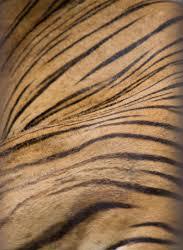
They are solitary and territorial animals; cubs (big cat offspring are not called kittens) stay with their mother for 2 years. These cats are found throughout Asia—although they are endangered—and their population is dwindling.
Lions

Lions are a social species of large cats found in the grasslands and savannas of Africa. Males are recognizable by their long hair surrounding their necks, called manes. Lionesses do the hunting for the pride (social group of lions), which is comprised of several adult males, related females, and cubs. These animals are listed as vulnerable, which means they are close to becoming endangered.
Jaguars

Jaguars are the only member of the Panthera genus found in the Americas. Individual cats can be found in the Western United States, but they have had a reduced range in Central and South America since the early 20th century. They are solitary animals and ambush predators, hunting in tropical and subtropical forests and swamps. They are recognizable by their spots, which are black rosettes with spots in the middle. However, melanistic (or all black) jaguar occasionally appear; these cats are informally known as black panthers—although they are not a separate species—and the phrase “black panther” has been used to describe melanistic leopards as well. Jaguars are near-threatened, which means their numbers are decreasing and their populations are being closely monitored.
Leopards

Leopards have a wide range and are found in Sub-Saharan Africa, in parts of Western and Central Asia and on the Indian subcontinent. They are recognizable by their spots; they look like jaguars with their spotted fur, but leopards are shorter with a smaller head, and their rosette-shaped spots do not have dots in the middle. Leopards are opportunistic hunters, hunting mostly on the ground at night; though in the Serengeti, they are known for attacking prey by leaping from trees. Leopards are listed as vulnerable, meaning they are potentially on their way to the endangered species list.
Snow leopards
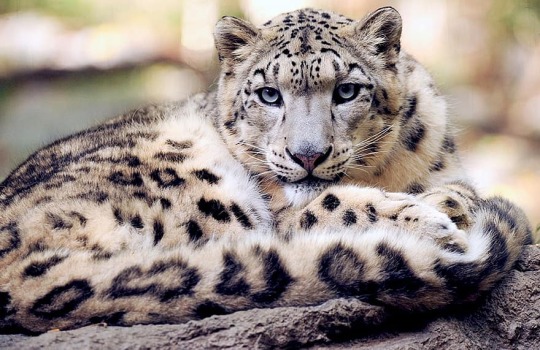
Snow leopards live in the mountain regions of Central and South Asia, living at elevations from 3,000 to 4,500 feet. Their fur is whitish grey, with black rosettes, distinguishing them from other leopards which are yellow or brown in color. Snow leopards have large nasal passages which helps warm the cold, dry air they breathe. Their tails are covered thickly with fur and provide fat storage; sleeping snow leopards use their warm tails like blankets to protect their faces when they sleep. They are listed as vulnerable, meaning they may appear on the endangered species list in the future.
Clouded leopards

There are two species of clouded leopards—the mainland clouded leopard (Neofelis nebulosa) and the Sunda clouded leopard (Neofelis diardi). The mainland clouded leopard is found in the Himalayan foothills in Southeast Asia and southern China and the Sunda clouded leopard is found in Borneo and Sumatra. They are considered an evolutionary link between two cat families Pantherinae and Felinae. Their fur is dark grey with a black blotched pattern. Clouded leopards are solitary and hunt by stalking or ambushing prey. They are excellent climbers and use trees as rest sites. Both species of clouded leopards are listed as vulnerable, meaning they can potentially end up on the endangered species list.
Cougar
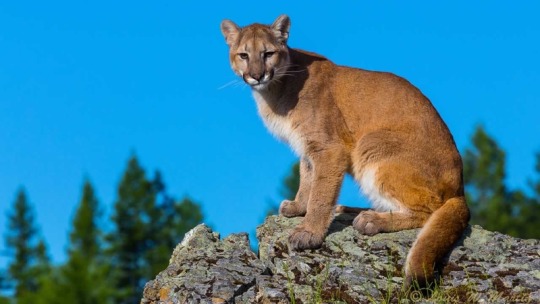
The cougar (also known as a puma, mountain lion, red tiger, or catamount) is the only cat on this list that you may see in the wild around Pittsburgh; however, their populations are severely reduced in the eastern half of North America. These cats are adaptable to a wide variety of habitats, which is why they are found all throughout North and South America. This wide range is the reason people living in different regions have different names for them. They are ambush predators, preferring to hunt deer, though they will eat insects and rodents. While cougars are large, they are not always the apex (or top) predator and will occasionally give food they caught away to jaguars, grizzly bears, or even alligators! Cougars are listed as least concern, meaning their population is holding steady, though their range has shrunk.
Cheetah

Cheetahs are known for their speed; as the fastest land animal, they are capable of running up to 80 miles per hour! Cheetahs can be found in the Serengeti, Saharan mountain ranges, and in hilly areas of Iran. Cheetahs separate into three kinds of social groups—females with cubs, all-male groups, and solitary males. Females are more likely to travel further distances while males will establish and stay in smaller territories. They are active during the day and spend most of their time hunting for things like impala or springbok. Cheetahs are listed as vulnerable, with one of the main threats being a lack of genetic diversity, which makes it difficult for the species to adapt and evolve over generations, reducing the chance for individual animals to survive.
Eurasian lynx

The Eurasian lynx is found from Europe into Central Asia and Siberia, living in temperate or boreal (snow or Taiga) forests. They have short, red-brown coats, and are more colorful than most animals sharing their habitat. In the winter, their fur grows in thicker and greyer. These cats have relatively long legs and large webbed and furred paws that act like snowshoes, allowing them to walk on top of the snow. They have bobbed (or short) tails, much like one of their cousins you might see around Pittsburgh—the bobcat. They hunt small mammals and birds but will occasionally take down young moose or deer. The Eurasian lynx is listed as least concern, with a stable population.
Jo Tauber is the Gallery Experience Coordinator for CMNH’s Life Long Learning Department, as well as the official Registrar for the Living Collection. Museum staff, volunteers, and interns are encouraged to blog about their unique experiences and knowledge gained from working at the museum.
#Carnegie Museum of Natural History#Big Cats#Meowfest#KidsBurgh#Eurasian lynx#Cheetah#Cougar#Clouded leopard#Snow leopard#Leopard#Jaguar#Lion#Tiger
263 notes
·
View notes
Text
Unexpected presence of great white sharks in Gulf of California
https://sciencespies.com/nature/unexpected-presence-of-great-white-sharks-in-gulf-of-california/
Unexpected presence of great white sharks in Gulf of California
Perhaps no other ocean creature lives in the human imagination like the great white shark. But while great white sharks might be plentiful in the minds of beachgoers across the country, there are only a handful of places in the world where white sharks can be consistently found. In those areas — such as Central California, Guadalupe Island Mexico, South Australia and South Africa — they tend to be found aggregated in small hotspots, often located around seal colonies.
Researchers have estimated that white shark populations are incredibly small, with only hundreds of large adults and a few thousand white sharks total in any of their global populations. This has made protecting white sharks a priority for conservation with many countries, including the United States and Mexico, having laws in place to prevent the catching and killing of the species.
After uncovering a previously unknown white shark hot spot in the central Gulf of California, however, a new study involving University of Delaware assistant professor Aaron Carlisle suggests that these low numbers for eastern north Pacific white sharks, especially those listed in the Gulf of California, might be underestimated. In addition, the researchers found that the mortality rates for these white sharks might be underestimated as well, as an illicit fishery for the species was uncovered in the Gulf of California, suggesting that fishers were killing many more white sharks than has been previously understood.
The research findings were published in Conservation Letters. Daniel J. Madigan, of the Department of Integrative Biology at the University of Windsor in Ontario, Canada, served as the lead author on the paper and Carlisle, assistant professor in UD’s School of Marine Science and Policy in the College of Earth, Ocean and Environment, served as a co-author on the paper.
Underestimated Mortality
For this study, Madigan interacted with a small group of local fishermen and over several months that group killed about 14 large white sharks. Of these, almost half could have been mature females. This was a conservative estimate as other groups reportedly killed additional sharks during this time.
advertisement
To show just how significant this new source of mortality might be, Carlisle pointed to a National Oceanic and Atmospheric Administration (NOAA) endangered species act status review on white shark populations from 2012. Using the best available information at the time, the NOAA report estimated that the adult female mortality rate for the entire eastern Pacific was likely around two annually.
“He found, in just a two-week time period, more mortality in this one location than what we thought for the whole ocean,” said Carlisle. “It was pretty clear then that, well, something kind of important is happening here.”
Carlisle explained that the mortality estimate of the earlier NOAA study could have been off because calculating mortality for animals in the ocean — figuring out how many die naturally or unnaturally — is one of the most difficult population metrics to quantify.
What makes this finding particularly interesting is that this population of white sharks — the eastern Pacific population of white sharks — is perhaps the most well-studied group of sharks on the planet. Here, in the midst of all this scientific research, was a seemingly robust population of white sharks that had eluded scientific study.
“It’s been about 20 years since a new ‘population’ of white sharks has been discovered,” said Carlisle. “The fact that the eastern Pacific has so much infrastructure focused on white sharks and we didn’t know that there were these sites in the Gulf of California was kind of mind-blowing.”
Future steps
advertisement
Now that the aggregation has been identified, Carlisle said that there are many more scientific questions that need to be answered.
There is a pressing need to study and quantify the population of sharks in the new aggregation site. In particular, it is unknown whether these sharks are part of the other known populations of white sharks in the eastern Pacific, which include populations that occur in Central California and Guadalupe Island Mexico, or whether they belong to a third, unknown population.
They are also interested in finding out how long the aggregation sites have been there and how long people have been fishing at the sites.
“One of the big points of this paper was to raise the red flag and let managers and scientists know that this is going on and this population is here and needs to be studied,” said Carlisle. “Hopefully, it will be studied by some local researchers who are invested and working with the local fishing communities because these fishing communities are all heavily dependent on marine resources and fisheries.”
Carlisle stressed that the researchers are not looking to cause problems for the local fishing communities that they worked with for the study.
Instead, perhaps there is an opportunity for these communities to learn about other opportunities with these animals through avenues like eco-tourism, educating them on the fact that these sharks are worth more and could provide a steadier stream of revenue alive rather than dead.
“This seems like it would be a perfect situation for ecotourism, much like there is at Guadalupe Island,” said Carlisle. “There could be huge opportunities to build businesses around these populations of sharks, and that’s just from a management point of view. From a science point of view, there’s all sorts of fun things you could do.”
Still, Carlisle said that more than anything, this paper highlights just how little we know about what is going on with sharks in the ocean.
“Even though we’ve studied these animals so much, we still know so little,” said Carlisle. “How many fish are in the ocean is a very old but very hard question to answer.”
#Nature
1 note
·
View note
Text
Volunteers Dig In to Help Save Native Plants in Washington
Our 9,382 dedicated U.S. Fish and Wildlife Service volunteers in the Pacific Region gave an incredible 198,914 hours of their time to conservation in 2018. That is the equivalent of 24,864 eight-hour work days and 95 full-time staff members! These incredible folks deserve a huge thank you and during National Volunteer Week (April 7-13) we are aiming to do just that. This is the first in a series of blogs about U.S. Fish and Wildlife Service volunteers and projects. Share your story of service or honor an outstanding volunteer by telling us about it with #iServeBecause, #volunteer and #NationalVolunteerWeek on Facebook or Twitter.

By Heidi Newsome, wildlife biologist at Hanford Reach National Monument and Central Washington National Wildlife Refuge Complex.
Hanford Reach National Monument, once set aside for the production of nuclear weapons, may seem an unlikely place to be important for rare plant conservation. The Manhattan Project, however, protected a hundreds of thousands of acres of eastern Washington shrub-steppe habitat, making it an island of conservation for 127 populations of 30 rare plant species.
It’s also where you’ll find another uncommon specimen – volunteer Jane Abel.
Jane, along with her husband Keith and other members of the Washington Native Plant Society, have invested numerous hours in work focused on conservation of rare species within the Central Washington National Wildlife Refuge Complex, and in particular on the Hanford Reach National Monument along the Columbia River.
A refuge biologist like me is often a jack-of-all-trades and master of none, needing to have a knowledge of the biota of the area including plants, animals, insects, mollusks, fungi; and all of the abiotic factors affecting them including soils, hydrology, weather, climate, chemistry, and their numerous interactions. Volunteers provide a needed resource and expertise managing the resources that belong to all of us.
Thankfully, Jane – a plant enthusiast with a combination of intelligence, drive and devotion – came to my aid. She was a perfect fit to help me move projects forward. I had begun experiments in 2005, partnering with the Washington State Department of Natural Resources’ natural heritage program botanist to try to germinate and grow seedlings of the Umatnum desert buckwheat and the White Bluffs bladderpod. In 2009, Jane began assisting in monitoring the extant populations of these species. By 2010, we had collected native seed for Jane to attempt to germinate and grow.
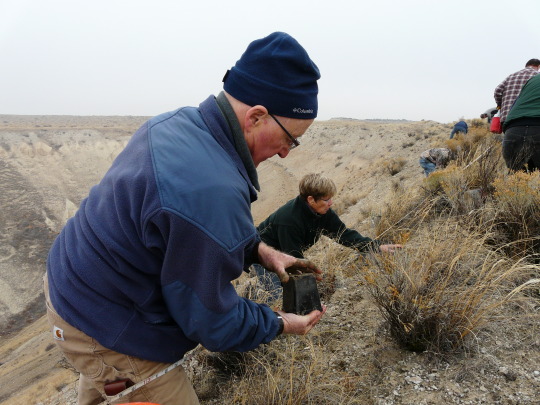
“I don't remember how or when I blurted out, ‘I will grow these for you!’” Jane said. “It was almost shocking to me that there wasn't more of an attempt to grow native plants and try to colonize them on the Hanford Monument. I slowly realized that commercial growers were able to produce the common woody shrub-steppe plants in large quantities, but it would not be profitable for them to grow fussy endemics that require fine-tuned growing conditions and some odd concoction of specialized soil.”
The very first task Jane took on was to develop her own soil medium, based on information from the literature and observations of both plants in their natural setting. Both Umtanum buckwheat and White Bluffs bladder pod grow in unique soils – the buckwheat on bare, rocky basaltic ridgelines; and White Bluffs bladder pod on caliche (calcium deposits).
Keith built tables for the seedlings to grow on in their yard. Jane closely cared for and observed the plants, watering, using a light, organic fertilizer, and providing shade cloth during summer heat to promote seedling development.
Umtanum buckwheat has been one of the more challenging plants to grow, Jane said.
“At first I had difficulties finding the right components for a fast draining soil mix and next was pot size – too big and it would be impossible for volunteers to chip through rocks and dig a hole for planting; too small and the roots would overheat on the growing tables in July and August. The solution was smaller pots enclosed in thick wooden boxes to protect the roots in summer.”
Jane was able to germinate 60 seeds and developed 42 seedlings of Umtanum desert buckwheat for outplanting in 2011, and she germinated more than 200 seeds and develop 187 seedlings of White-bluffs bladderpod in 2013!

From 2010 to 2016, Jane nurtured, grew and produced 569 seedling Umtanum desert buckwheat starts. We outplanted them in eight distinct areas on the Hanford Reach National Monument.
Thanks to Jane and others, we’ve learned so much. We discovered how to successfully germinate and propagate this species, and how to grow seedling plants. We learned that Umtanum desert buckwheat can be successfully pollinated in a garden setting and produce viable fertile seed. We have evaluated several planting sites, and learned that Umtanum desert buckwheat will not persist in the loamy soil, and that some rocky component of the soil seems required for establishment. Truly remarkable information to glean from determined volunteers with an interest in plants!
From 2013 to 2015, Jane also produced 856 seedling White Bluffs bladderpod starts. We have outplanted them in two distinct areas on the Hanford Reach National Mounument and monitored their survival. Our plantings have produced 105 seedlings in the wild! We discovered how to successfully germinate and propagate this species, and how to grow seedling plants. We compared outplanting in fall versus spring seasons for this species, and documented flowering, seeding and reproduction from our outplanted starts!
“While we had great difficulty in getting (Untanum desert buckwheat) seedlings to establish, it was so thrilling to discover that our (White Bluffs bladderpod) actually started to re-seed on its own! I made a very loud squeal and dropped all of the equipment when I turned around and faced a large clump of healthy blooming Physaria (bladderpod) during our survey,” Jane said.
Again, a truly remarkable conservation action accomplished with the power and dedication of volunteers.
In addition to raising the seedlings, Jane and Keith also assisted in the back-breaking work of installing these plants in rocky and inhospitable areas. Also with additional volunteers, they took multiple trips to water the seedlings as they were getting established, and assisted in monitoring annually to help document the success of these projects. Jane calls the little plants her “babies” and has expanded her work in growing rare plants of the region to include coyote tobacco (Nicotiana attenuata Steyd.), Wormskiold’s northern wormwood (Artemisia campestris var. wormskioldii), Columbia yellowcress (Rorippa columbiae), and Western false dragonhead (Physostegia parviflora).
Both Umtanum desert buckwheat and White Bluffs bladderpod were listed as Threatened under the Endangered Species Act in 2013. Conservation and management actions, such as those that have been ongoing at the Hanford Reach National Monument, are critical to the recovery of both species.
And volunteers like Jane and Keith are critical, too.
Jane’s and Keith’s enthusiasm, concern, devotion and passion for the work of conserving native plants has kept me going on these projects. I could not have done this work without them! The U.S. Fish and Wildlife Service would not have accomplished as much without these special volunteers. They have truly made an impact for conservation of the flora of Washington State.
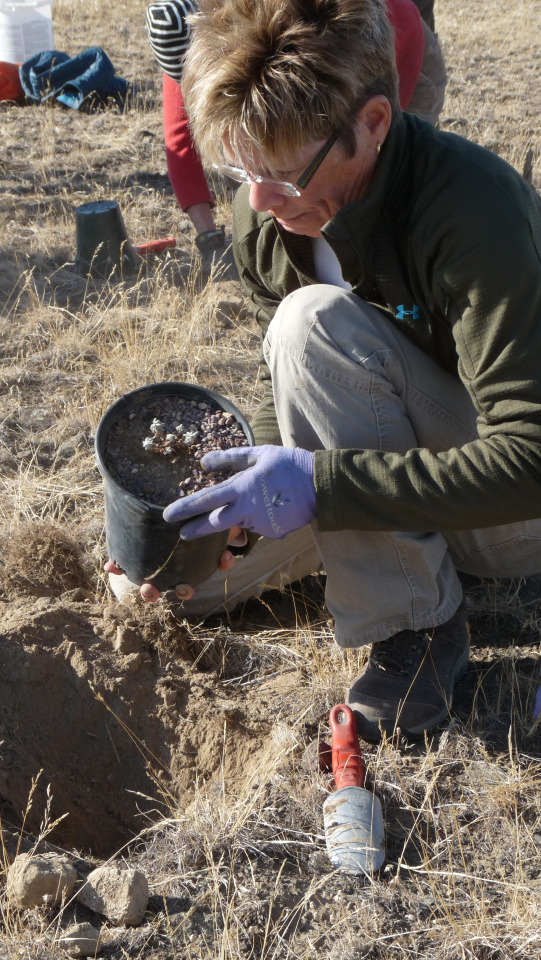
11 notes
·
View notes
Photo

How a Zoo Decides Which “High-Risk” Animals Should Get a COVID VaccineBY
MOLLY OLMSTEAD
JULY 28, 2021
Earlier this month, the Philadelphia Zoo announced that some of its animals would soon receive an experimental COVID-19 vaccine for some of its “high-risk” animals. Several other zoos have already begun to vaccinate their animals, with no sign of any major issues. To understand how a zoo comes to decide which animals are high-risk and how to balance the concerns about a new vaccine with the risk of COVID, Slate spoke with Dr. Keith Hinshaw, the director of animal health at the Philadelphia Zoo. This interview has been condensed and edited for clarity.
Slate: Can you explain how this came about?
Keith Hinshaw: We have lots of very endangered primates here at the zoo that are closely related physiologically to human beings and so are susceptible to many of the same viruses and bacteria and parasites. In January of 2021, there was an outbreak of COVID-19 in the gorilla troop at the San Diego Wild Animal Park. To protect the other troop of gorillas that live at the actual San Diego Zoo, they had obtained a small amount of an experimental vaccine from the Zoetis Farm Animal Health company. When we found out that information, we contacted Zoetis directly. Those discussions happened in February. After learning about their vaccine, we asked if we could be put on a list of zoos and other facilities that would be interested in using it on their animals. So we submitted a list to them of the animals that were highest up on our list of priorities.
Which animals did you decide were at risk?
All of our primates. We also submitted our carnivores, which in our case is bears, animals in the weasel families such as otters, animals in the canid families such as our maned wolf, and then a few other miscellaneous carnivores, such as the red pandas, the meerkats, and a thing called a fossa. We did not submit our list of bats because our bats are behind glass, so there’s not really any air exchange with guests. And we didn’t think that they would be as susceptible to actual illness. So 81 primates and 37 carnivores. In their press release, Zoetis said they’re donating 11,000 doses to zoos and sanctuaries and other institutions, so two doses for each of the animals that I mentioned is 236 doses.
How did you determine what the at-risk animals were?
There are actual studies where they would see if they could demonstrate that an animal could get infected with the COVID virus. And then there was also a paper published where they did computer modeling to see if the actual shape of the receptor on the lung cells of different species of animals would match up with the shape of the spike protein on the SARS CoV2 virus. It is very theoretical, but it did predict, as you might expect, primates would be susceptible, and cats were up there.
So you presented all of these animals as equally at risk, as equal priorities?
For our request to obtain the vaccine, we simply submitted the list, not in any particular order. In reality, once we obtain the vaccine, there is probably a logical order: the great apes—gorillas and orangutans—and then the big cats—lions, tigers, leopards, jaguar—because those are the animals that we know have already been infected at other zoos.
We’re constantly monitoring both the lay and the scientific press for stories about animals that could potentially be susceptible. And every zoo has to make their own decisions. Some zoos may not use it at all. And some have decided to use it in an even wider-ranging group of animals. If evidence came up that other species appeared to be susceptible, we would certainly add them to that list.
Is this vaccine different from human COVID vaccines?
Yes. This is what I would call a standard vaccine for animals. It does not contain a live virus in it. And it doesn’t contain mRNA. It just contains the antigen, which is a synthesized version of that spike protein from the SARS CoV2 virus, and then a chemical that’s added to make your body’s immune system pay more attention. There’s no virus in there or anything else that might cause any sort of illness. The Zoetis people are recommending two doses three weeks apart, which is pretty standard.
Would you administer different doses to, say, a gorilla and a lemur?
No, they get the same dose. For most vaccines we use in the zoo, it’s the same dose no matter what size the animal. There are some exceptions—the rabies vaccine, for example—but in general, it’s a set amount. You’re using the vaccine to get the attention of the immune system, and you don’t necessarily need to use a lot.
What have you heard from other zoos that have already begun vaccinating their animals?
I haven’t heard anything bad. I do know that they’ve done safety trials. And I know they did those trials with dogs and cats and demonstrated that you get an antibody response. The American Association of Zoo Veterinarians has a very active listserv, and there is a lot of interest from the veterinarians to know how things are going with zoos that are starting to implement this vaccine. And when I communicated with Zoetis last week about this, they had not received any reports from anyone of adverse reactions.
If there were adverse reactions, would you reassess?
Exactly. We will always be paying close attention to whether or not there’s any problems with this vaccine or any other medication in zoo animals. One of the things that makes veterinary medicine interesting is that other than maybe a few parrots—and we’re not totally clear on what is going on there—they can’t tell you what they’re feeling. But I will say that the animal keepers are very observant and will pay very close attention to their animal’s behavior. They’ll know what side of the mouth the animal chews food on, how fast they blink, how fast they stand up and lie down. And so if they see anything that seems different, they’ll give us a call.
What would it take for you to call off the vaccinations?
Say we gave an animal this vaccine, and for a day, it only ate half as much food as it normally would eat, and then from that point on, it was back to normal again—I would not consider that a serious side effect. If we gave the vaccine and the animal went off food completely and seemed like it was in a lot of discomfort, then we would think more carefully. Or say it developed an abscess at the vaccine site, like a severe kind of localized reaction. That would be a little bit concerning, and we would have to think carefully about using this vaccine in that species. But other zoos are implementing the vaccine and have not reported any severe side effects. So, so far, so good. And then the more tricky ones, I guess, would be longer term side effects; you might not know for a long time if there’s an issue. But given the technology of the vaccine, which is a fairly standard animal vaccine, I don’t anticipate that we will see those effects either.
Did you have to have a serious conversation about risk before you agreed to do this?
We did have the conversations. We have a weekly meeting with the zoo veterinarians, the nutritionists, the curators, the director of the zoo, our records people, and so on. We felt it was important to talk about it. Every zoo is going to have to make their own decision. Like if you’re in an area of the country that has low community transmission of COVID, and your keeper force is fully vaccinated, and if you’re in a climate where a lot of the animal housing and activities happen outdoors, you may not see that as necessary.
There was an outbreak of COVID-19 in a group of lions at a zoo in India in May with the delta variant. The outbreak that you heard about in the Bronx Zoo in April 2020 was with the original strain. Those cats went off feed for a little bit; there was some coughing and some nasal discharge, but they didn’t really require any intervention. These lions in India got really sick, and two of them died. So now if you’re a zoo veterinarian, and before you weren’t too worried about this, now maybe the delta variant is a little more of a potential hazard. That could sway your opinion.
Is your concern just about the animals getting sick?
There’s been little evidence that animals can transmit the virus back to people, at least from domestic dogs and cats and so on. The CDC says that pets are not really considered as a major source of the virus. But there were some issues when this virus got into mink farms in Europe, and they detected the virus was going back into the workers at those farms. We don’t have mink here, and we’re not ever planning on having them, but we do have otters and they’re in the same family as mink. So one of my concerns is that if we did have an infection in our animals, does that put our keepers at any risk? So that would be a second reason. The third reason is that anytime that a virus infects a person or an animal, you can get more variants created, so we want to minimize that.
How hard will it be to actually administer the vaccines?
We do have a vaccination program already in place. At our zoo, a tiger for example would normally get three vaccines every year. Most of the cats and the great apes—the gorillas and orangutans—are trained for voluntary vaccination, so they will be easy to vaccinate. And then the smaller animals are trained to go into a little mesh box, so those will be fairly easy. The trickier ones are going to be some of the mid-sized primates that maybe aren’t so interested in voluntarily being injected and are also super smart. In our case—other zoos may have better behaved ones—our gibbons are ridiculously smart, and they have not responded as well to the operant conditioning for training voluntary injections. So if I would have to pick [the hardest] one, I would say the gibbons. For those animals, we would probably do the vaccine as part of a regular physical exam under anesthesia.
So where do things stand now for your plans?
We submitted our list of animals that we were interested in vaccinating in late February. Zoetis needs to get approval from each individual state Department of Agriculture. In our case, it’s the Pennsylvania Department of Agriculture, and there are some forms and paperwork that they need to complete. When I communicated with them a couple of weeks ago, I think they said they were working on 85 different approvals. We’re hoping to receive our first doses some time in the next month or so.
Is there anything else that you wanted people to know?
We would love it if more people would get vaccinated. The virus is actually on the upswing because of the delta variant, and so we’re a little concerned that we could still have our animals exposed one way or the other. So here’s one more person telling you that if you are eligible to get the vaccine, and you haven’t gotten it yet, please do so because it’s going to also protect our animals here at the zoo.
0 notes
Text
Webcomic Whimsy: Tame
Welcome to the Woohooligan Weekly Webcomic Whimsy! If you're a webcomic author and would like a review, you can see my announcement and review rules here.
Title: Tame
Author: Tailzkip (of the illegibile signiature :P) • Patreon • Facebook • Twitter • DeviantArt • YouTube
Site: Webtoon (some earlier chapters are also on Tapas where I read them)
Genres: Horror, Modern, Black Comedy, Drama(?), Action(?), demon rules-lawyering, young people make the worst decisions
Rating: PG, T for Teen(?) - some violence
Updates: 15 page chapters at a time (I assume not every week)
My Starting Point (requested by artist): Beginning
Synopsis (from Webtoon): Kioshi lost everyone close to him during an explosion at his school's festival and ever since he has had the ability to see demons. With his demon Nekeo at his side, Kioshi must make it through the grieving process and move forward in his life.
Tame seems like an interesting concept. A demon growing to love the guy who's passive-agressively trapping him into a contract that the guy doesn't even give a shit about... It's sort of like where Anime meets one of those Life Time movies about someone struggling with addiction or alcoholism. The characters seem to be trapped in cycles of horrible decisions that endanger, hurt, and even kill themselves and everyone around them, and have no notable benefit to compensate for all the destruction (at least as far as I can tell from what i've read)... but with a healthy dose of PUN-ishing comedy.
If you enjoy manga, demons and black comedy, I think it's worth a look!

Oh, look! A big bowl of foreshadowing!


Well so far we're only seeing one shape and size, which appears to be a cat with some kind of alien parasite on the end of it's tail? Seems like these three panels could have been condensed and not taken up a whole page.

The start still feels a little sluggish, but we're getting somewhere... mass murder in the diner and the waiter, Kioshi, is blaming it on a demon, and presumably (since he's off camera) the police investigator is humoring him instead of just sending him away for the padded-room guys to deal with.
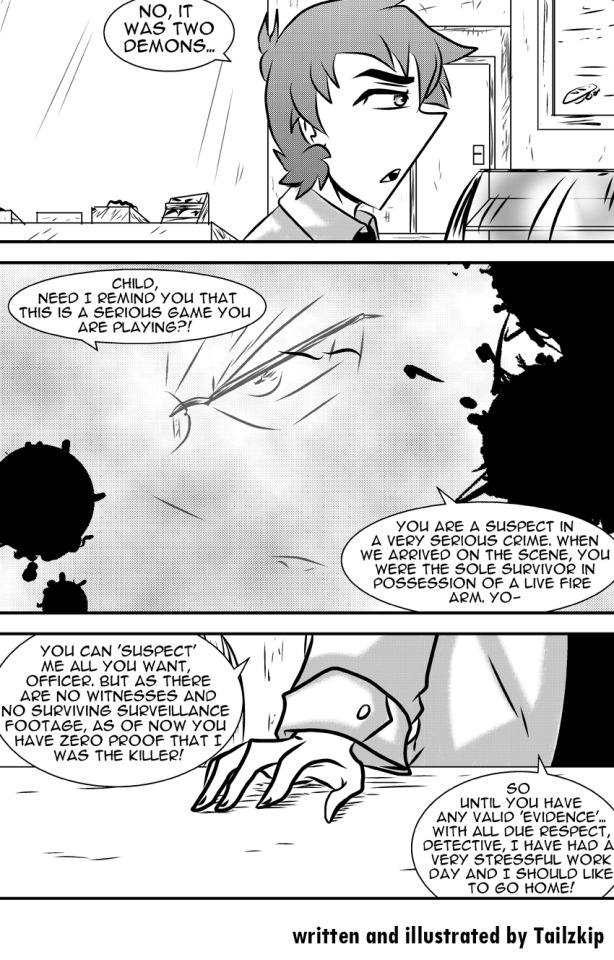
Wait... is the cop a demon? Why do we only get to see part of his face surrounded by blood spatters? Is Kioshi tripping balls? That would explain a lot. Plus he seems pretty balsy for the prime suspect in a mass murder while being a waiter... how's he going to pay for his legal defense? Big tippers in his town?

"I didn't mean literally."

Is he not a waiter? If not, then why was he wearing a bloody apron? He swiped it off a waiter when the shooting started? Didn't want blood on his nicely wrinkled, untucked shirt?

Okay! We went from "parked car" speed to "is time dilating?" in about two pages flat. Not that I mind it picking up speed, but it's a little whiplashy. And I feel a flashback coming on.

Flasbhack. Called it! Ow, the whiplash! No information in this page outside of the fact that buildings are on fire and demon kid's got some weird hair.

That's a pretty weird way to define a contract... "Hey Humpty, gimme a hot-dog with extra relish! ... Damnit, I entered into a demon contract AGAIN!"

Greedy? It's not like he asked for extra relish... but I guess that slave-form thing is pretty convenient for Kioshi.

I don't think anyone can figure out what that is... Alien invasion? The world's largest hula-hoop?

A special summons from a corrupt monk... damn, that was my next guess.

Sooo... he's faster and a better escape artist in his slave form than his true form? That's a pretty lousy slave if the slave form is harder to control.

I see the part where the demon is becoming tame has started... he violated one of the "demons will not..." clauses at the beginning by moving in with Kioshi. So if this is true to form, the rest of the series is Nekeo violating one of those things every chapter or so.

And there we have it, the whole hunt-down the terrorists thing is a McGuffin to give Kioshi a reason to keep a mass-murdering demon around, because... he's cute, in a mass-murdery sort of way.

Did I say cute mass-murderer? I meant cut mass-murderer bent on destroying any hope you have of happiness in this life or the next. So... Kioshi is a clinically depressed massochist who won't settle for a regular cat, because why have that when you could have people dropping dead around you on the daily, yo?

Is he "SO DEAD!" Or "sooo... dead"? I'm getting the sense Kioshi is also bi-polar.

Wait... the demon Nekeo has horrible eldritch powers that helped you escape the collapse of a burning building, and later murder a diner full of people... but not so much keeping him from catching the flu? Like... when it comes to medical, I've got an upper hand over this demon because I have Purell.

I always bake using antifreeze... it's the only way to keep the cookies soft in the frozen tundra.

I dunno... doesn't seem like it's the cat-demon that needs to pick up on things.

You know he can hear you, right? He's still a cat.

She's served for generations and she's fine, but Nekeo needs to jump from contract to contract and 3 years is too long... hmmm... Also, this Konno kid is way too smarmy for a 14 yr old.

This starts a short action sequence where this Kireina demon-girl is all blood-lust trying to kill Nekeo, so Kioshi and Nekeo are running to try and get away until Konno confusingly stops her, which he said he couldn't do.

And right on schedule, Nekeo violates the 2nd list item at the end of chapter two.
That's the end of my hour of reading after two chapters, and whatever happened to that cop with the ghost face? What about the murderous grandma next door? So many questions.
One other thing I'll mention is that as I was reading, I forgot that Kioshi is supposed to be grieving a loss of family and friends. It's really not mentioned IN the story, just in the synopsis. The only thing that comes close is the mention of the terrorist attack and the collapse of the building, but that scene only describes the creation of the contract with Nekeo, it doesn't give any backstory or insight into Kioshi's mental state. Some mention of the family and friends he lost (presumably in the terrorist attack) in the story would likely help explain why his behavior is so self-destructive.
While there's a fair amount that could use improvement in the first couple chapters, I think the concept has some potential. If you enjoy manga, demons and black comedy, give it a read!
If you are a webcomic author and are interested in a review from me, you can check out my announcement and my review-request rules here.
If you enjoyed this and want to help me make more reviews, you can contribute on our Patreon or if you're short on funds you can also help by checking out and sharing my own comedy and laughtivist webcomic, Woohooligan!
Thank you for sharing yourself with us!
Sam
1 note
·
View note
Text
Where to Find Parking Near Popular Atlanta Attractions
Nicknamed the Big Peach, Atlanta, is undoubtedly one of the most happening cities in Georgia. Here you'll get to experience the fabulous lifestyle of the South. There's always plenty of places to visit and things to do in Atlanta. However, trying to find cheap parking in Atlanta can be rather tiresome. On-street and on-site parking near Atlanta's most popular attractions is almost always costly. If you were wondering where to start from, we've got a list of the top Atlanta attractions and where to find parking near them.
Georgia Aquarium
Visit one of the largest indoor aquariums in the world and enjoy an out-of-this-world experience! With 10 million gallons of water spread out across saltwater and freshwater pools, Georgia Aquarium in the city had to be on the list of top places to visit in Atlanta. Watch giant Beluga Whales and Whale Sharks as they dive underwater. Catch dolphins frolicking and penguins waddling. Get up close and personal with sharks, rays, and starfish at any of the touch pools! This is one Atlanta attraction that you won't get enough of, so we recommend that you book your parking near the Georgia Aquarium in advance. The best places to park near Georgia Aquarium are on Marietta Street and Luckie Street.
Atlanta Botanical Garden
A veritable oasis of greenery, the Atlanta Botanical Garden that stretches 30 acres is a sensory experience not to be missed. Home to over 2,000 rare orchid species, this Atlanta also boasts of a delightful edible garden. Those tempted to have a nibble can chomp down on their favorite picks at the outdoor kitchen, which also offers a cooking demo. You can experience the beauty of a high-rise garden at the Kendeda Canopy Walk. Some of the best parking spots near the Atlanta Botanical Garden can be located on South Spring Street and South Grand Avenue.
Zoo Atlanta
Home to more than 1000 animals, including several endangered species, Zoo Atlanta has to be one of the top places to visit in Atlanta. Watch the playful Giant Pandas playing at the Asian Forest or the orangutans chilling at the Asian Forest (Zoo Atlanta is home to one of the largest zoological populations of orangutans). Take a peek at the baby lemurs in the Living Treehouse! Feed the Parakeets at the 'Boundless Budgie' exhibit or hang out with the creepy crawlies at the reptile house. Kids will have a fun time riding the zoo train or paddling around in the splash fountain. If you want to visit Zoo Atlanta, we recommend that you park either at Edgewood Avenue or Memorial Drive.
World of Coca-Cola
Learn more about the world's favorite fizzy drink at the 120-acre World of Coca-cola in the city. Go through the list of exhibits showcasing the drinks' history and get a selfie taken with the legendary Coca-Cola polar bear. Treat your taste buds to a variety of Coke flavors from the world over. Chill out at the Coke theatre, which screens a six-minute 'Moments of Happiness' movie for visitors. Listen to stories from an interactive wall and go for a virtual secret formula hunt at the sensory 4D theater! If you intend to visit the World of Coca Cola, you can park in one of the lots on Williams Street or Ted Turner Drive North West.
Fox Theatre
You don't need to go all the way to New York to watch a theatrical show! Visit the legendary Fox Theatre, one of the best places to visit in Atlanta, to catch some of the country's finest live entertainment performances. A former movie palace is a performing arts venue that can comfortably seat more than 4000 patrons. While there, check out the 'Mighty Mo,' the second-largest theater organ in the world - a 3,622-pipe organ that was custom-made for The Fox by M.P. Möller. Peachtree Street and North Avenue NE have lots that offer parking near Fox Theatre.
Centennial Olympic Park
Don't miss one of the top things to do in Atlanta- riding the Skyview Atlanta, a 20-story long Ferris Wheel at the city's Centennial Olympic Park. Once you are done with this Atlanta attraction, try to catch a show at the Fountain of Rings, an interactive water fountain with computer-controlled lighting. If you are lucky enough, you can even watch a live concert in style sitting under the stars! You'll find parking lots on William Street of Walton Street if you're looking to park near Centennial Olympic Park.
Fernbank Museum
If you are a dinosaur nerd, visiting the Fernbank Museum of Natural History in Ponce is one of the best things to do in Atlanta! This top Atlanta attraction houses a vast collection of dinosaur fossils. Watch fascinating 3D nature flicks on the biggest movie screens in Atlanta. Go on an adventure quest through its indoor forests. Those with an eye for art can scroll through a massive collection of 18th-century Spanish artifacts. If you plan to visit the Fernbank Museum, we recommend parking on Mclendon Avenue or North Highland Avenue.
Six Flags over Georgia
Move around this amusement theme park covering 290 acres, and you will be amazed at the number of Warner Bros. Characters and themes that you bump into! Taking an amusement trip around the Six Flags theme park located at Cobbs County is highly recommended among the list of top things to do in Atlanta. The park boasts a variety of famed amusement rides, including the rollercoaster Goliath. Those looking to beat the summer heat can visit the nearby waterpark, spread across 7 acres. If you're visiting Six Flags over Georgia, the best places to park nearby can be at the Wyndham Hotel or in the official Six Flags Lot.
CNN Center
Take a trip to the city headquarters of America's first news only television network on an exclusive behind-the-scenes tour. You'll get to take a look inside its special effects studio and catch newsfeeds from CNN bureaus the world over. Watch live news broadcasts in the making and take in action behind the scenes. Going behind the anchor's desk and getting your photograph is definitely one of the top things to do when you are at this major attraction in Atlanta! Some of the best places to park near the CNN Center are Marietta Street or Cone Street.
Atlanta Hartsfield Jackson International Airport
The Atlanta Airport can be considered a destination in itself. With amazing food and drink options, 250 artworks, and tons of shops, Atlanta Airport is a pretty nice place to be in once you're inside. Getting to Atlanta Airport is another thing entirely and can be quite challenging. If you're driving to the airport, on-site ATL parking can pricey and challenging to access. If you are looking for more affordable Atlanta airport parking options, choose parking near ATL instead of at the airport. These parking lots near ATL offer better prices, be booked ahead of your travel, and are more easily accessible.
A city loaded with history, fun, and a warm climate, there is no shortage of incredible places to visit in Atlanta, like the Delta Flight Museum. From kids to seasoned art lovers, there are plenty of exciting things to do in Atlanta. So, try to spend your time and money enjoying all the fun things that Atlanta has to offer rather than circling around looking for a parking spot. Parking in Atlanta does not have to break the bank. By booking your Atlanta parking space in advance, you can make your visit to the top attractions in Atlanta easy and hassle-free.
0 notes
Text
After Decades Long Battle, Cheetahs Can Be Reintroduced in India
https://sciencespies.com/news/after-decades-long-battle-cheetahs-can-be-reintroduced-in-india/
After Decades Long Battle, Cheetahs Can Be Reintroduced in India
Cheetahs once darted across the Indian subcontinent, their numbers so plentiful that the revered Mughal emperor Akbar was said to have kept a stable filled with 1,000 of the spotted creatures. But by the mid-20th century, the cheetah had been declared extinct in India, pushed to the brink by threats like habitat destruction and overhunting. Now, as Joe Wallen of the Telegraph reports, the country’s supreme court has ruled that the fleet-footed cats can be reintroduced to the country on an experimental basis, approving a plan that has divided conservationists.
The court’s ruling was prompted by an application filed by India’s National Tiger Conservation Authority, which sought permission to transfer cheetahs from Namibia, according to the Hindustan Times. In light of the ruling, authorities will move forward with identifying a suitable habitat for the program, assessing such factors as prey availability and the potential for human-cheetah conflict. Among the sites that have been suggested for the relocation are the Kuno-Palpur Wildlife Sanctuary in Madhya Pradesh, the Velavadar National Park in Gujarat and the Tal Chapar sanctuary in Rajasthan.
As Namrata Kolachalam reported for the Atlantic in September, the Indian government has spent decades trying to bring cheetahs back to the country. As far back as the 1970s, officials tried to secure the big cats from Iran, which today is home to the world’s last stand of Asiatic cheetahs—a struggling population of fewer than 50 individuals. Conservationists worked to increase populations of cheetah prey like the Indian antelope and Indian gazelle. But negotiations crumbled after the Islamic Revolution of 1979.
Decades later, plans to clone Asiatic cheetahs also came to naught. So proponents of the reintroduction program shifted focus to importing African cheetahs, a distinct subspecies from the Asiatic cheetah.
The new approach has drawn criticism from both conservationists and scientists. For one, experts are divided over the degree of genetic differences in cheetah subspecies, and whether those differences matter. “It would be like having an African lion in a wild park in Europe,” conservation geneticist Pamela Burger of the University of Veterinary Medicine in Vienna tells Kolachalam of the reintroduction plan. “Of course, you can have that, but then it’s an African lion living in Europe. Not a European lion.”
There are more acute concerns, as well. According to the Hindustan Times, some activists say that none of the proposed habitats in India are large enough to accomodate cheetahs, and that these areas do not have enough prey to sustain the big cats. “Serengeti National Park in Tanzania has an area of 14,750 square kilometres brimming with prey base,” the publication notes. “[T]he proposed Indian wildlife habitats do not have an area of more than 1,000 square kilometers, and with much less prey base than the African homes of cheetahs.”
Also fuelling concerns is India’s inconsistent record when it comes to managing big cats. Thanks to intensive conservation efforts, the country’s tiger populations are said to be growing at a rapid rate. But lions that were introduced to the Chandraprabha sanctuary in Uttar Pradesh in the 1950s were “poached out of existence,” according to the BBC. In the summer of 2019, it was revealed that more than 200 lions had died in the Gir forest region of Gujarat, mostly due to infections and illness. Environmental lawyer Ritwick Dutta of the Legal Initiative for Forest and Environment in India tells Kolachalam that the plan to introduce cheetah’s to India’s natural landscape is “a clear case of misplaced priorities,” one that will detract from efforts to protect endangered species already living in the country.
But some conservationists are enthusiastic about the possibility of bringing cheetahs back to India. The animals are listed as “vulnerable” by the International Union for Conservation of Nature, and transporting African cheetahs to new habitat could improve their long-term viability, Kolachalam writes. Proponents also say that the reintroduction project will only move forward once potential habitats have been fully assessed for their habitat, prey stock and risk of human-cheetah conflict.
Former environment minister Jairam Ramesh, who initiated the reintroduction program ten years ago, said he was “delighted” by the Supreme Court’s ruling. “It is,” he claims, “a momentous occasion.”
#News
6 notes
·
View notes
Photo

Alligators make terrible pets: 'You're basically dealing with a dinosaur.'
New Mexico officials seized this seven-foot American alligator (seen here at his new home, the ABQ BioPark Zoo) from a private home, where he'd been kept illegally for a decade.
A rise in the abandoned reptiles around the United States—including two recently found in a Kansas creek—has raised concern among experts.
JULY 31, 2020
Something unusual was lurking in Wildcat Creek, in Manhattan, Kansas, a small college town on the prairie. In June, townsfolk spotted two American alligators��swimming in a body of water better known for reptiles such as garter snakes and painted turtles.
Further investigation revealed that a thief—still at large—had stolen the gators from a local pet shop and released them into the creek. Rescuers set humane traps to catch the animals, but the female, Pebbles, died after falling into the water inside one of these traps. The male, Beauregard, eluded capture until late July, when a construction worker caught and returned him to his owners at Manhattan Reptile World, according to their Facebook page.
The two gators, kept at Manhattan Reptile World under a state zoo permit, had previously been illegal pets, living in a pool and a bathtub in Manhattan and Kansas City, according to a news release. (Learn more about why people want exotic pets.)
The incident—particularly the female’s untimely death—highlights the often problematic, yet not widely known, phenomenon of keeping pet American alligators, which are native to the U.S. Southeast, experts say. (Read more about the exotic pet trade.)
Formerly endangered, American alligators reached their nadir in the 1950s because of overhunting and habitat loss, but conservation efforts returned the species to healthy numbers by the mid-1980s. Weighing up to a thousand pounds, these behemoths live in wetlands, rivers, lakes, and swamps, feeding primarily on fish, turtles, snakes, and small mammals. (Watch alligators on the hunt.)
Official numbers on how many American alligators are kept as pets don’t exist, but some states have estimates. There are likely 5,000 in Michigan; at least 50 in Phoenix, Arizona; and as many as 52 of the prehistoric reptiles are surrendered to the city of Chicago each year.
American Alligator, Alligator mississippiensis
TYPE: Reptile
DIET: Carnivore
GROUP NAME: Congregation
AVERAGE LIFE SPAN IN THE WILD: 35-50 years
SIZE: 10-15 feet
WEIGHT: 1,000#
In recent years, wildlife officials across the nation have noticed an uptick in alligators abandoned in parks, creeks, and other public places. In 2019, six pet alligators went on the loose in Detroit (one was shot to death), and in August, the New Mexico Department of Game and Fish seized an alligator from a Santa Fe man who had kept the animal illegally for 10 years.
Gator laws
Ownership laws for alligators vary by state and municipality. While keeping them is legal in Michigan, parts of Detroit ban private ownership. In other states, such as New Mexico, pet gators are illegal without a permit, and in Arizona and New York, private ownership is banned.
Such regulations don’t faze many collectors who covet palm-size baby gators. A quick search for pet alligators turns up dozens of websites that sell juvenile alligators for anywhere from $150 to $15,000 (for an albino animal). Most of these young reptiles come from legal alligator breeders in the Southeast who sell the animals wholesale to vendors.
The black market trade of these animals has long been “a big problem,” according to Matt Eschenbrenner, director of animal care and conservation at the Great Plains Zoo and Delbridge Museum of Natural History, in Sioux Falls, South Dakota. It’s likely that most of these animals originate in Florida, says Russ Johnson, president of the Phoenix Herpetological Society.
Florida has strict alligator farming laws and inspection protocols, but not all breeders play by the rules. In 2018, the state reported 21 active alligator farms that produced legal hides and meat. Not present on this list are unlicensed operations that illegally breed gators as pets. (Read about the largest seizure to date of illegally caught reptiles.)
Bone breakers
Most gator pet owners are unprepared to care for an adult animal that can reach 14 feet and live 80 years, Johnson says. When that cute baby gets bigger and less manageable, the owner faces a real conundrum. “It’s not like owning a cat or dog that will return love,” he adds. “You’re basically dealing with a dinosaur.”
To capture their prey, alligators are armed with strong jaws lined with up to 80 teeth. If captive gators don’t get enough food—a common problem—they can get cranky and bite, easily breaking through human bone. “It’s not the alligator’s fault,” Johnson says. “The alligator was just being an alligator.”
This happens, he says, because feeding an alligator is expensive. Adults need nourishment such as whole chickens or pork with the bone, and Johnson says he pays about $150 a month to feed each adult alligator at his rescue facility.
Alligators also need a large pool of water to thrive. Bathtubs and kiddie pools, preferred by many pet owners, aren’t good enough, Eschenbrenner says. Buoyancy relieves the weight of an alligator’s internal organs, and if the water isn’t deep enough for a gator to float, it can suffer pain and even die from the pressure of its own internal weight. Plentiful water helps alligators feel safe and calm in their environment, he adds.
The right temperature is a requirement too. As natives of the U.S. Southeast, alligators are used to living in a warm-to-hot environment, and pet owners may need to use several heat lamps to keep the cold-blooded animals warm, Eschenbrenner says.
Health woes
Because many people keep pet alligators illegally, the animals miss out on routine veterinary care. As a result, serious health problems may go unchecked for years.
Eschenbrenner recalls one alligator rescued from a home in New Mexico that had been kept in a kiddie pool for a decade. The animal was obese, but even so, poor nutrition had stunted its growth and caused dental problems—it was unable to fully close its mouth because the top and bottom jaws were misaligned.
Many pet alligators develop weakened bones because of a nutrient-poor diet, such as hamburger meat or deboned chicken. One alligator rescued in Arizona was so low on calcium that its jaws were “like a rubber band,” Johnson says. Another was so malnourished that it broke its back leg while trying to escape rescuers.
Unnatural surfaces can be harmful: One alligator raised on a glass platform had a disfigured skeleton because of improperly settled bones.
Considering the difficulties of keeping an alligator, much less a healthy one, it’s no surprise that when the animals become too difficult to care for, their owners abandon or kill them—or surrender them to the authorities, Johnson says.
Good homes for gators
There are people trying to make life better for abandoned alligators. For example, the Phoenix Herpetological Society, in Arizona, provides a natural, semi-wild habitat for 15 rescued alligators at its 2.5-acre sanctuary—along with a number of other abandoned, abused, and confiscated reptiles. The facility, which has an on-site reptile clinic and research center, aims to find permanent homes for many of its animals, often sending them to other reputable sanctuaries around the country.
Female crocs lay their eggs in clutches of 20 to 60. After the eggs have incubated for about three months, the mother opens the nest and helps her young out of their shells.
Alligators' heads are shorter and wider than crocodiles'. Although heavy and slow on land, they can ambush their prey from the water by lunging at speeds of 30 miles (48 kilometers) per hour.
Nile crocodiles are the largest crocodilians in Africa, sometimes reaching 20 feet (6 meters) long.
Saved from the brink of extinction, the American alligator now thrives in its native habitat: the swamps and wetlands of the southeastern United States.
Critically endangered, the prehistoric-looking American crocodile struggles to survive in pockets of shrinking habitat.
The largest crocodilians on Earth, saltwater crocs, or "salties," are excellent swimmers and have often been spotted far out at sea.
American alligators are found in freshwater coastal wetlands across the southeastern United States, from Louisiana to the Carolinas.
Mother Nile crocodiles lay their eggs in a buried nest, opening it when high-pitched squeaks are heard from within. The sex of baby crocs is dependent upon the temperature of the nest rather than genetics.
The best solution, Eschenbrenner says, is not to own an alligator in the first place. “I would never have an animal like this as a pet, period.”
A good option for alligator enthusiasts is to appreciate them from a distance by supporting conservation groups or a certified zoo that keeps the animals properly for public education, he says.
Owning one is “doing an injustice to this animal,” Eschenbrenner says. “You’re causing it more harm than good.”
Wildlife Watch is an investigative reporting project between National Geographic Society and National Geographic Partners focusing on wildlife crime and exploitation. Read more Wildlife Watch stories here, and learn more about National Geographic Society’s nonprofit mission at nationalgeographic.org. Send tips, feedback, and story ideas to [email protected].
0 notes